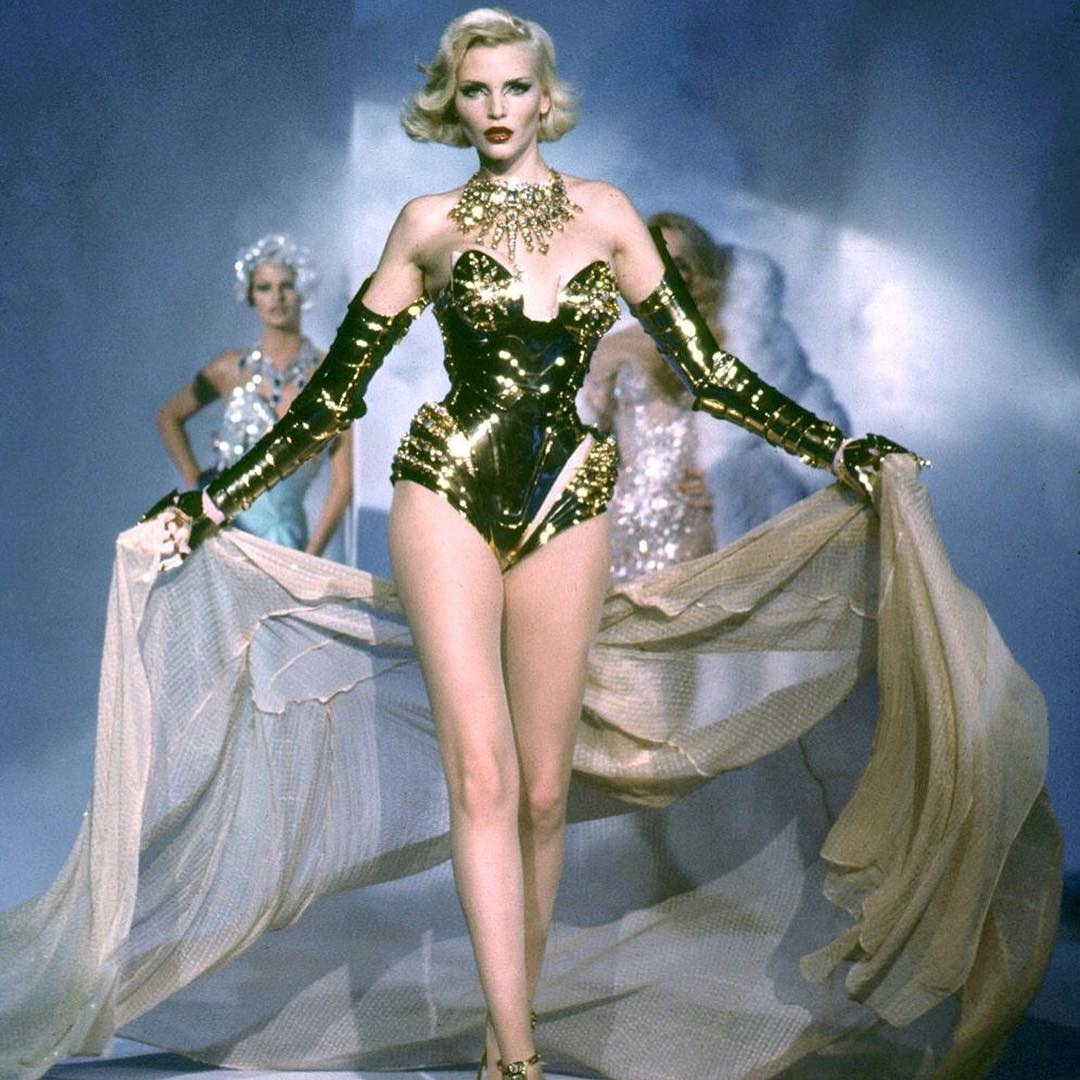Mugler - The Prophet of Futurism
Nadja Auermann for Thierry Mugler, F/W 1995. Available from: https://captainofhopes.tumblr.com/post/182449271495/nadja-auermann-for-thierry-mugler-fw-1995
Thumbnail Photo: Simonetta Giarfelici wears an evening ensemble from the Thierry Mugler Ready-to-Wear Autumn/Winter 1995 "Twentieth Anniversary at the Cirque d'Hiver" collection. Available from: https://www.vogue.co.uk/article/manfred-thierry-mugler-back-in-fashion
BY HANNAH SCHMIDT-REES
With Cardi B's recent outing to the 2019 Grammys in his archived 1995 Fall Collection 'Birth of Venus' gown, it seems like the French designer Thierry Mugler has been brought back into the spotlight.
Simonetta Gianfelici for Thierry Mugler Spring 1997 Haute Couture. Available from: http://miss-mandy-m.tumblr.com/post/157629109680/throwback-thursdays-simonetta-gianfelici-for
Moving to Paris at the age of 19 in 1968, Thierry Mugler started working as a window dresser at a Parisian boutique called 'Gudule', and began designing on the side. After years of freelance design in London and Amsterdam, Mugler returned to Paris in 1973 with his first collection under his own name; full of bold and structured power-dressing and sparkled decoration; motifs that he became renowned for years later.
From his starting point, Mugler began to create a vision of a bold and confident woman, dressed in only the most beautiful and creative garments. A vision that truly came to fruition in the 1990s, when Thierry Mugler reached his prime.
Mugler, through his garments with structured shoulders, exposing corsetry and unique fabrics, communicated an aesthetic that was the perfect meeting point between the 1940's Hollywood actress and the 1980's powerful businesswoman, spawning looks that are both classic and futuristic. He combines masculine cuts with the traditional feminine hourglass figure, using sharp angles to contrast with the natural curves of a woman's body. In addition, Mugler combined his iconic silhouettes with abstract concepts, including nature, insects and even cars. Mugler used drama in his tailoring to create the idea of an extravagant, feminine personality. A widow of a rich husband, a businesswoman who would always get what she wanted, a Hollywood actress that all the boys fawned over, a femme fatale with an interest in the erotic. He also turned women into FemBots, Insect Queens and futuristic Egyptian Goddesses. Mugler created powerful women through his clothing, women with personalities.
And one more thing, Mugler wasn't one to shy away from a dramatic runway show either. Runway shows today typically run for no longer than 10 minutes. At his prime, Mugler's shows ran for almost an hour. With models (most notable being; Naomi Campbell, Cindy Crawford, Linda Evangelista and Jerry Hall) also taking on the additional roles of actresses and walking art, Mugler didn’t just give you a runway show, he gave you a performance that was simply unforgettable. In his A/W 1995 show, (the 20th anniversary of the Mugler brand), one model lit a cigarette while making her way down the runway. Imagine that happening today?
Apart from his work with many celebrities, including Lady Gaga, David Bowie, George Michael and Beyonce, Mugler's label was bought out in 2003. Whilst Mugler is no longer designing new collections, his legacy is still respected and revered to this day. The work of Thierry Mugler achieved an aesthetic that has never been easily executed; the fusion between old Hollywood and the unpredictability of the future.
If you asked me about my favourite designers, Thierry Mugler would definitely be on the list. My two favourite decades of fashion are the 1940s and the 1980s, so just from an aesthetic point-of-view, Mugler and I are a match made in heaven. The graphic and structured nature of his clothing, exaggerated silhouettes, unreal materials and progressive themes never cease to amaze me. And whilst I’m constantly blown away by his work, but his approach to the relationship between femininity and clothing is something that I truly admire. In the world today, the role of a runway model is to be a 'walking mannequin', the clothing perceived as more important than the woman wearing it. The reason I love Mugler's garments is because it makes you see the woman in the clothing. The lifestyle, interests and personality of the woman is just as important as the cuts, fabrics and colours of the clothing she wears. The garments envelop her body like it’s a second skin, like it’s simply an extension of who she is. His clothing gave each model a personality without her having to say a word; she’s powerful, influential, confident and unique; and only one look at her proves it.
Mugler used clothing to strengthen a woman's identity, not to hinder her or to make her less important than the clothing she wears.

